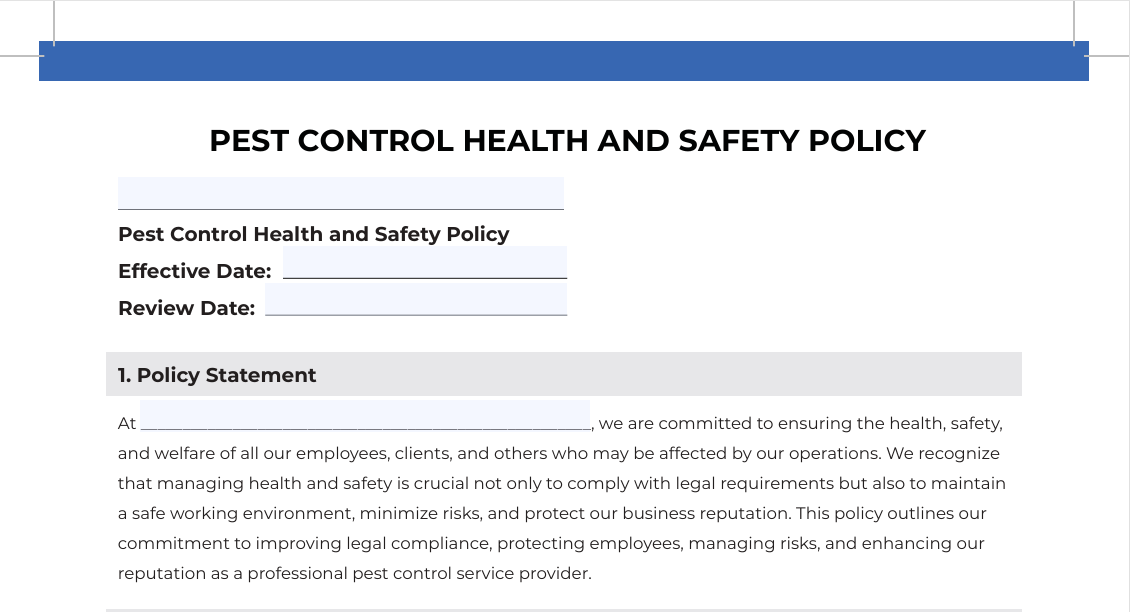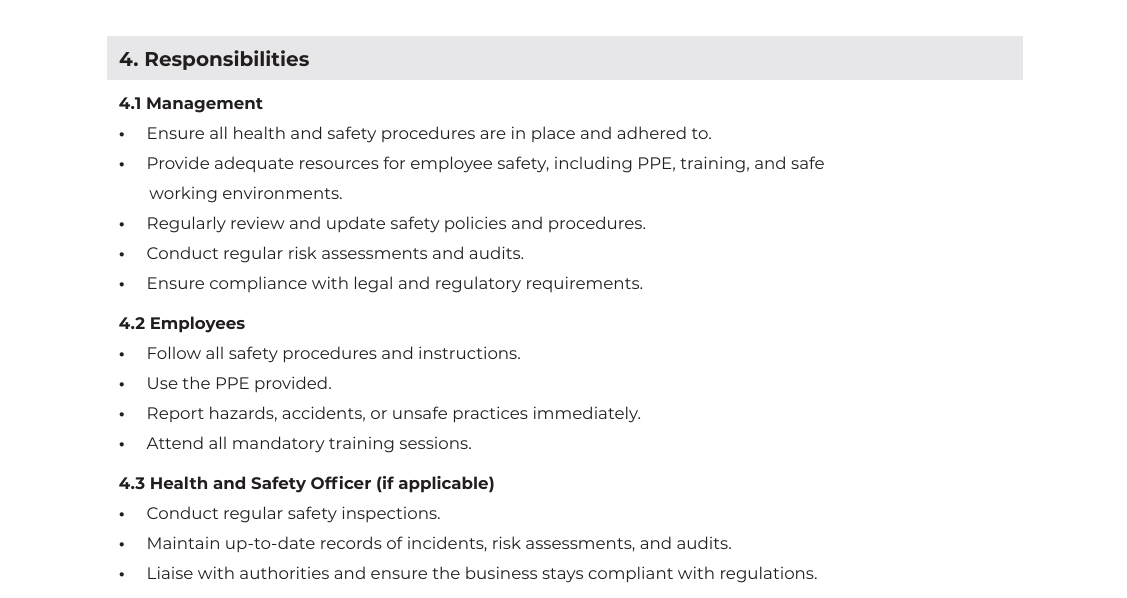Free Pest Control Health & Safety Policy Template (+PDF Download)
A well-designed pest control estimate showcases professionalism and expertise, ultimately helping boost retention, earn referrals, and win new clients.
Using a template to build estimates streamlines operations by reducing manual tasks, helping you bid and win more jobs. At the same time, it frees up bandwidth so you can think strategically about growing your business.
But there’s an art to designing an effective pest control estimate template. Capturing too little information will create problems downstream, such as homeowners who feel surprised by payment terms. Likewise, capturing too much information will slow down your field service, leaving less time to schedule new jobs.
In the pest control industry, ensuring health and safety is paramount. This guide will delve into the importance of a robust health and safety policy, outlining its essential components and the legal requirements that pest control companies must meet.
We'll explore the potential consequences of non-compliance, including legal liabilities and risks to employee safety. Implementing a comprehensive health and safety policy is not just about compliance; it's about creating a safe working environment, preventing accidents, and fostering a safety culture within your organization.
We offer a free, customizable pest control health and safety policy template to support you in this endeavor. This template helps you quickly establish a policy that meets industry standards and legal requirements.
Download Our Free Pest Control Health & Safety Policy Template

How to Use Our Free Pest Control Health & Safety Policy Template
Design our user-friendly and customizable free pest control health and safety policy template to fit your specific company’s operations.
Download the Template: Start by downloading the free template.
Customize the Policy Statement: Adjust the policy statement to reflect your company’s commitment to health and safety.
Fill in Company Details: Enter specific company information, including the name, address, and contact details.
Specify Responsibilities: Clearly define the responsibilities of management, supervisors, and staff members regarding health and safety, including addressing specific pest problems.
Detail Safety Procedures: Include specific procedures for handling pesticides, using personal protective equipment (PPE), pest control measures, and emergency protocols.
Adapt to Local Regulations: Ensure the template aligns with local health and safety regulations and standards.
Add Company Branding: To personalize the document, incorporate your company’s logo, colors, and other branding elements.
Customizing the template ensures it fits your company’s unique needs and maintains a professional appearance.

What is a Health & Safety Policy?
A health and safety policy outlines a company’s commitment to maintaining a safe and healthy work environment. It serves as a roadmap for employees, detailing procedures and responsibilities to minimize risks and ensure compliance with safety regulations.
This policy benefits businesses by reducing accidents, improving employee morale, and demonstrating a commitment to legal and ethical standards.
A clear, well-documented policy is not just a set of rules, it's a tool for fostering a culture of safety and responsibility in pest control operations. It's a testament to your company's commitment to the well-being of your employees and the communities you serve.
Why Does My Pest Control Company Need a Health & Safety Policy?
A comprehensive health and safety policy is not just a requirement, it's a strategic asset for your pest control company. It ensures legal compliance, protects your employees, manages risks, and enhances your business reputation. It's a comprehensive safety net for your operations.
Legal Compliance: It ensures your company meets regulations like OSHA standards, reducing the risk of fines and legal issues.
Employee Protection: Implementing personal protective equipment (PPE) and safe working practices demonstrates a duty of care, safeguarding your staff from hazards like pesticide exposure.
Risk Management: It identifies and mitigates specific risks, such as pest infestations, manual handling, and hazardous substances, preventing accidents and injuries. For instance, it helps identify and manage pest problems like carpenter ants and bed bugs to prevent them from escalating.
Business Reputation: A strong safety record, backed by a robust health and safety policy, builds customer trust and enhances your company’s reputation in the pest control industry.
Next, we’ll explore the essential components of a pest control health and safety policy.
What Are the Essential Components of a Pest Control Health & Safety Policy?
A comprehensive health and safety policy for a pest control company includes several key components to ensure a safe working environment and compliance with regulations:
Policy Statement: Management commits to prioritizing health and safety in all operations. It should outline the company’s dedication to maintaining a safe workplace and the roles and responsibilities of all staff members.
Risk Assessments: Conducting thorough risk assessments is essential. This process involves identifying potential hazards, evaluating their associated risks, and implementing control measures to mitigate them. For example, assessing the risk of pesticide exposure and determining the necessary personal protective equipment (PPE) to protect employees.
Safety Procedures: These are detailed instructions on handling chemicals, using equipment, and dealing with various pest scenarios. Safety procedures should include PPE requirements, such as wearing respirators when applying pesticides, using fire extinguishers in case of chemical fires, and following proper manual handling techniques to prevent injuries. Procedures should include specific treatments for pests like carpenter ants and bed bugs.
Emergency Response: Protocols for dealing with accidents, spills, and exposure to hazardous substances are crucial. This section should detail specific procedures for different emergencies, such as evacuating the area in case of a large chemical spill or administering first aid for pesticide exposure.
Chemical Storage and Handling: Safe practices for storing, transporting, and disposing of chemicals are vital to prevent accidents and environmental contamination. This includes guidelines for labeling chemical containers, using appropriate storage facilities, and following COSHH (Control of Substances Hazardous to Health) regulations.
Training and Supervision: Ongoing education and support for employees are necessary to maintain a safe workplace. This component should cover specific training topics like integrated pest management (IPM), proper use of pesticides, and recognizing signs of pest infestations. Supervision ensures that employees adhere to safety protocols and continue to develop their skills.
Reporting and Record-Keeping: Procedures for documenting incidents and near-misses help track safety performance and identify areas for improvement. This includes maintaining safety data sheets, recording pest sightings, and keeping logs of training sessions and safety audits.
Policy Review and Update: Regularly reviewing and updating the policy ensures it remains effective and compliant with current regulations. This process should involve evaluating the policy annually and making necessary adjustments based on new health regulations, pest control methods, or staff member feedback.
Having these components in place protects employees and professionalizes your pest control policy.
What Are The Legal Requirements for Pest Control Health & Safety?
Understanding and adhering to legal requirements is crucial for maintaining a safe working environment in the pest control industry. Key regulations include:
Overview of Relevant Laws and Regulations: In the US, the Occupational Safety and Health Administration (OSHA) sets guidelines for safe working practices, including using personal protective equipment (PPE), handling hazardous substances, and record-keeping. Compliance with OSHA standards ensures pest control companies implement necessary safety measures and have adequate pesticide applications.
Potential Penalties for Non-Compliance: Failure to comply with health and safety regulations can result in significant penalties, including fines, legal action, and reputational damage. Non-compliance can also increase the risk of accidents and injuries, further impacting the business.
Resources for Further Information and Guidance: Companies can access resources from OSHA, the Environmental Protection Agency (EPA), and industry-specific organizations like the National Pest Management Association (NPMA) for comprehensive guidelines and regulation updates. These resources provide valuable information on best practices, safety procedures, and compliance requirements.
Compliance with regulations requires year-round attention to health and safety practices. By understanding and implementing these legal requirements, pest control businesses can ensure a safe working environment and avoid legal complications.
Next, we will discuss how often you should update your health and safety policy.
How Often Should I Update my Health & Safety Policy?
Update a health and safety policy annually to keep it relevant and effective. Review and revise it whenever regulations, processes, or equipment used in pest control services change. For example, if you introduce new pesticides or implement updated safety procedures, the policy must reflect these changes. Regular updates help you maintain compliance with health regulations and ensure a safe workplace.
Next, we will explore the consequences of not having a health and safety policy.
What Happens if I Don't Have a Health & Safety Policy?
Without a health and safety policy, pest control companies face increased risks of accidents and injuries. Legal issues can arise from non-compliance with health regulations, leading to potential fines and penalties. Due to the increased risk of claims, insurance costs may be higher.
A lack of a safety policy can damage a company’s reputation, making it harder to attract and retain clients. Without a policy, it becomes difficult to rid the workplace of pests, increasing health risks effectively. Overall, not having a safety policy jeopardizes the safety of staff members and the business’s success.
Next, we will discuss whether legal counsel is necessary to create a health and safety policy.
Do I Need Legal Counsel to Create a Health & Safety Policy?
While you do not need legal counsel to create a health and safety policy, you should ensure full compliance with all relevant regulations. Consulting with a legal expert can help identify potential issues and ensure the policy meets all legal standards.
Next, let's explore how FieldRoutes can enhance safety and streamline operations.
Going Beyond the Basics: FieldRoutes for Enhanced Safety
Using FieldRoutes complements your health and safety efforts in a pest control business by enhancing compliance and ensuring that all safety protocols are meticulously followed and monitored.
FieldRoutes Operations Suite is a comprehensive pest control business software designed to streamline operations, improve safety, and enhance profitability. Key features include:
Drag & Drop Scheduling: Easily assign and manage technician routes to ensure efficient service delivery and reduce time spent on scheduling.
Optimized Routing: Create the most efficient routes for technicians, minimizing travel time and reducing the risk of accidents.
Robust Reporting: Generate detailed reports on safety compliance, incidents, and operational efficiency to identify areas for improvement.
Automated Communication: Schedule reminders and updates for staff and customers, ensuring everyone is informed and reducing the risk of miscommunication.
Pipeline Visibility: Keep track of job progress and employee performance to ensure safety protocols are followed.
FieldRoutes helps pest control businesses simplify operations and improve safety, allowing them to focus more on delivering quality service and growing the company.
The Bottom Line
A comprehensive health and safety policy is crucial for pest control companies to ensure compliance, protect employees, and maintain a safe working environment. Our free pest control health and safety policy template streamlines the process of creating an effective policy that covers all necessary aspects, such as risk assessment, use of pesticides, and emergency response protocols.
FieldRoutes enhances your safety by providing features like optimized routing, automated reminders, and detailed reporting, contributing to safer and more efficient operations.
Ready to elevate your pest control business? Schedule a free demo for FieldRoutes Operations Suite.